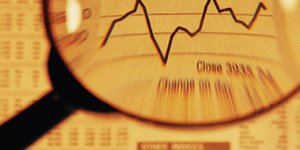Because of record bullishness and manipulative efforts to keep air in the bubble, the 4-year cycle advance out of the 2002 low was stretch. In fact, the cycle that began in October 2002 and that ended in January 2008 was one of the longest cycles in stock market history. In my work with the 4-year cycle there are two distinctly different data sets. One, provides me with statistical norms and averages surrounding the 4-year cycle. This data gives us a "yard stick" with which we can measure current cycles and the expectation of future cycles. Secondly, I have a number of very specific "markers" that are used to identify 4-year cycle lows. In fact, most of these markers have been present at every 4-year cycle low since 1896. One of the many important aspects of these markers is that they tell me when the 4-year cycle has topped and when the 4-year cycle has bottomed. Many erroneously proclaimed that the June/July 2006 lows or that the March 2007 low marked the 4-year cycle low. None of the historical markers that have occurred at previous 4-year cycle lows were present at either of these lows. Thus, all indications were that the 4-year cycle advance out of the 2002 low did not bottom in either 2006 or 2007 and my subscribers were very aware of this fact. As a result, this made the 2002 to 2008 cycle among the longest cycles ever. As an example, since 1896 there have been 27 completed 4-year cycles. The average duration of these 27 cycles has been 47 months. Of these 27 cycles, 13 have extended beyond 47 months. This makes sense in that half of the cycles have extended beyond the 47 month average and half have been shorter. Of the 13 cycles that have run longer than the 47 month average, the data reveals that the average duration of these cycles has been 54 months. From the October 2002 4-year cycle low to the October 2007 high was 60 months. As of the January 2008 low this cycle had run a total duration of 63 months. Since 1896 there has only been one other 4-year cycle that has stretched to this duration. As the equity markets rallied out of the January 2008 low I have been able to call every turn based on my statistical analysis and my Cycle Turn Indictor. I began telling my subscribers well in advance that we were facing the very real possibility of a "cyclical setup very similar to what was last seen in 1930." This has now come to fruition and it's not over.
I also use Dow Theory and I told my subscribers on November 21, 2007 that according to classical Dow Theory the Primary Trend had turned bearish. My views on this were challenged as the Transports moved to new highs in June 2008. But, I explained that under orthodox Dow Theory the previously established Primary Trend change that occurred on November 21, 2007 still remained bearish. This call proved correct and even though we have recently had a trend change, I continue to believe that it is within the context of a much longer-term secular Bearish market. All of these market calls are well documented in my newsletters.
Do you know anyone else who had documented forecasts one year in advance, warning about the sell-off in the equity markets in 2002? Did your broker or money manager ever once tell you this was going to happen? Did the "analysts" on CNBC warn you? What about the "experts" on Fox or CNN? I can assure you they did not see this coming. As for the current situation, I can also assure you that they did not see this top coming either. However, I did make these calls well in advance. The week of October 19, 2007 my intermediate-term Cycle Turn Indicator gave a sell on equities. Then, on November 21,2007 I stated that in accordance with Dow Theory a Primary Bearish Trend change has occurred. As for commodities, I gave my subscribers a very specific statistical benchmark to watch for in the summer of 2008, which unfolded perfectly. Did anyone tell you in July that commodities were facing an important top? Well, I told my subscribers. When I look at my statistical and cyclical analysis along with the historical bull and bear market relationships, the balance of the evidence suggests that this bear market still has much further to go. There will be rallies along the way and the cycles, statistics and my Cycle Turn Indicator will guide me at these important turns. As the market turns up out of these important lows we will hear the mainstream media telling us that the market has bottomed. Again, these guys did not see the top in equities in 2000 or 2007 or in commodities in 2008, much less the decline that has followed in either case. So, don't expect them to identify the bottom. Don't buy their Hype. We have note seen the bottom. The rally out of the March 2009 low has been a bear market rally within the context of a much longer-term secular bear market that has not yet run its course. The Phase II decline is out there and it should be far worse than the Phase I decline was. I have gone back to the inception of the Dow Jones Industrial Average in 1896 and identified the common traits that have accompanied every major market top. Thus, I know with a very high probability what this bear market top will look like and how to identify it.


